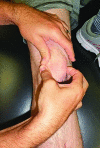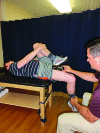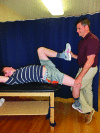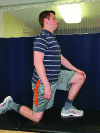CURRENT CONCEPTS AND TREATMENT OF PATELLOFEMORAL COMPRESSIVE ISSUES
- PMID: 27904792
- PMCID: PMC5095942
CURRENT CONCEPTS AND TREATMENT OF PATELLOFEMORAL COMPRESSIVE ISSUES
Abstract
Patellofemoral disorders, commonly encountered in sports and orthopedic rehabilitation settings, may result from dysfunction in patellofemoral joint compression. Osseous and soft tissue factors, as well as the mechanical interaction of the two, contribute to increased patellofemoral compression and pain. Treatment of patellofemoral compressive issues is based on identification of contributory impairments. Use of reliable tests and measures is essential in detecting impairments in hip flexor, quadriceps, iliotibial band, hamstrings, and gastrocnemius flexibility, as well as in joint mobility, myofascial restrictions, and proximal muscle weakness. Once relevant impairments are identified, a combination of manual techniques, instrument-assisted methods, and therapeutic exercises are used to address the impairments and promote functional improvements. The purpose of this clinical commentary is to describe the clinical presentation, contributory considerations, and interventions to address patellofemoral joint compressive issues.
Keywords: Flexibility; knee; patellofemoral compression; patellofemoral pain.
Figures






Similar articles
-
Strength around the hip and flexibility of soft tissues in individuals with and without patellofemoral pain syndrome.J Orthop Sports Phys Ther. 2005 Dec;35(12):793-801. doi: 10.2519/jospt.2005.35.12.793. J Orthop Sports Phys Ther. 2005. PMID: 16848100
-
The influence of abnormal hip mechanics on knee injury: a biomechanical perspective.J Orthop Sports Phys Ther. 2010 Feb;40(2):42-51. doi: 10.2519/jospt.2010.3337. J Orthop Sports Phys Ther. 2010. PMID: 20118526 Review.
-
Physical examination and patellofemoral pain syndrome.Am J Phys Med Rehabil. 2006 Mar;85(3):234-43. doi: 10.1097/01.phm.0000200390.67408.f0. Am J Phys Med Rehabil. 2006. PMID: 16505640 Review.
-
Effectiveness of static quadriceps stretching in individuals with patellofemoral joint pain.Clin J Sport Med. 2007 Jul;17(4):234-41. doi: 10.1097/JSM.0b013e3180f60afc. Clin J Sport Med. 2007. PMID: 17620775
-
Update on rehabilitation of patellofemoral pain.Curr Sports Med Rep. 2014 May-Jun;13(3):172-8. doi: 10.1249/JSR.0000000000000056. Curr Sports Med Rep. 2014. PMID: 24819009 Review.
Cited by
-
Electromyography Activity of Vastus Medialis Obliquus and Vastus Lateralis Muscles During Lower Limb Proprioceptive Neuromuscular Facilitation Patterns in Individuals with and without Patellofemoral Pain Syndrome.Phys Ther Res. 2021 Jul 30;24(3):218-224. doi: 10.1298/ptr.E10094. eCollection 2021. Phys Ther Res. 2021. PMID: 35036255 Free PMC article.
-
Effect of Daily Oral Lactobacillus plantarum PS128 on Exercise Capacity Recovery after a Half-Marathon.Nutrients. 2021 Nov 11;13(11):4023. doi: 10.3390/nu13114023. Nutrients. 2021. PMID: 34836278 Free PMC article. Clinical Trial.
-
Evidence based treatment options for common knee injuries in runners.Ann Transl Med. 2019 Oct;7(Suppl 7):S249. doi: 10.21037/atm.2019.04.08. Ann Transl Med. 2019. PMID: 31728373 Free PMC article. Review.
-
Comparison of instrument-assisted soft tissue mobilization and proprioceptive neuromuscular stretching on hamstring flexibility in patients with knee osteoarthritis.PeerJ. 2023 Dec 1;11:e16506. doi: 10.7717/peerj.16506. eCollection 2023. PeerJ. 2023. PMID: 38054019 Free PMC article. Clinical Trial.
-
The Effect of Self-Myofascial Release on the Pennation Angle of the Vastus Medialis Oblique and the Vastus Lateralis in Athletic Male Individuals: An Ultrasound Investigation.Int J Sports Phys Ther. 2022 Jun 1;17(4):636-642. doi: 10.26603/001c.35591. eCollection 2022. Int J Sports Phys Ther. 2022. PMID: 35693863 Free PMC article.
References
-
- Kannus P Aho H Jarvinen M Niittymaki S. Computerized recording of visits to an outpatient sports clinic. Am J Sports Med. 1987;15(1):79-85. - PubMed
-
- Blond L Hansen L. Patellofemoral pain syndrome in athletes: a 5.7-year retrospective follow-up study of 250 athletes. Acta Orthop Belg. 1998;64(4):393-400. - PubMed
-
- Baquie P Brukner P. Injuries presenting to an Australian sports medicine centre: a 12-month study. Clin J Sport Med. 1997;7(1):28-31. - PubMed
-
- Sherman SL Plackis AC Nuelle CW. Patellofemoral anatomy and biomechanics. Clin Sports Med. 2014;33(3):389-401. - PubMed
LinkOut - more resources
Full Text Sources
